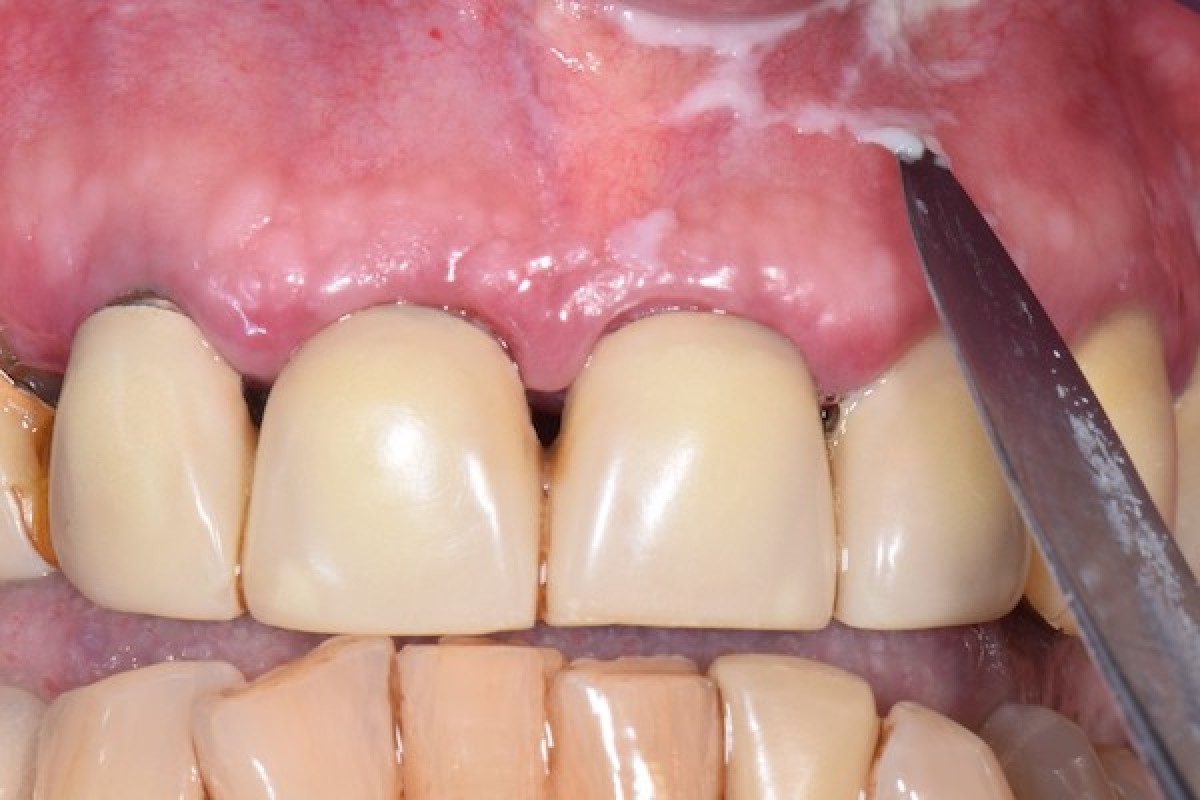
Multiple white lesions
Co-authors: F. Scotti, M. Mandaglio, S. Decani, E. Baruzzi
Giovanni Lodi
An 83-year-old female patient arrives in urgency complaining of noticeable exacerbation of the symptoms at the level of oral mucous. The patient, non-smoker and abstemious, follows a mixed diet with daily consumption of fruit and vegetables. The medical history turns out positive for osteoporosis, in therapy with denosumab. At the intraoral objective examination there are numerous whitish papules, confluent to form plaques, in correspondence of the arch and vestibular gingiva of the superior arch, posterior third of the mucous membranes and inferior fornice (fig. 1). The patient reports that she started starting around 4 weeks to apply clobetasol 0.05% gel on her gums and identifies the cause of the exacerbation of oral symptomatology in this therapy. On the basis of the clinical features of the oral lesions, the white lesions of the hollow cord are placed in differential diagnosis.
This type of lesions can be associated with very different pathological / paraphysiological conditions: lichen planus, leno- loid lesions (materials, drugs, lupus erythematosus or graft versus host disease), leukoplakias, candidiasis, spongy white nevus or chronic trauma. For this reason it is fundamental for the clinician to choose the appropriate diagnostic procedures, in order to know how to orient himself in the face of injuries of this kind. By clinically analyzing a white oral lesion, a first step towards diagnostic discernment can be provided by the so-called “scraping”, a maneuver that consists of the delicate rubbing of a rough object on the surface of the lesion (for example, a gauze), to assess whether it is removable or not. In case of positivity, the clinician has the possibility to focus mainly on the diagnosis of pseudomembranous oral candidiasis. In our case the "scraping" led to the total removal of the oral lesions, exposing a strongly erythematous area (fig. 2).
The regression of symptoms and oral lesions, following therapy with nystatin oral suspension, confirmed the clinical diagnosis of pseudomembranous candidiasis.Oral candidiasis is an opportunistic fungal infection caused by various species of the Candida family, mainly from the species C. Albicans.The predisposing factors may be of a systemic nature (age, immunological disorders, endocrine disorders, states of malnutrition, malignant neoplasia, prolonged use of antibiotics and / or immune suppressors) or local (hyposhala, the use of removable prostheses, and topical steroid therapies). In our case the patient underwent a steroid therapy applying clobetasol 0.05% on the gums, without following the prescription of the associated topical antifungal.
The diagnosis of candidiasis is essentially clinical and is based on the recognition of pathological lesions, such as the presence of removable pseudomembranes. The sites mainly involved in pseudomembryous candidiasis are the oropharyngeal mucosa, the palate, and the dorsal tongue. In this case it is interesting to observe the close topographical relationship between the distribution of the lesions and the sites of application of topical steroid therapy. The elective treatment of candidiasis is represented by the administration of topical antifungal, in gel formulation or rinsing. Among these, nystatin is the drug that represents the excellent treatment for costs and reduced number of interactions with other drugs. Other topical antifungals, such as miconazole or fluconazole, are in fact characterized by drug interaction with many other active ingredients, including oral anticoagulants, benzodiazepines and statins. In case of lack of responsiveness to the topical treatment the clinician can move towards a systemic antimicrobial therapy.
 Related articles
Related articles
Oral pathology 04 September 2025
The classic dental diseases, caries and periodontal disease, are commonly thought to have little effect on systemic health.
Oral pathology 23 June 2025
rtificial intelligence (AI) has rapidly advanced in healthcare and dental education, significantly impacting diagnostic processes, treatment planning, and academic training.
Oral pathology 07 May 2025
Antibacterial Effect of Juglans Regia Bark against Oral Pathologic Bacteria
In this study antimicrobial effect of ethanolic and aqueous extracts of Juglans regia bark in Iran was evaluated on four different oral bacteria, Streptococcus mutans, Streptococcus salivarius,...
Oral pathology 22 April 2025
The initial clinical description of lichen planus (LP) is generally attributed to Ferdinand Ritter von Hebra, who in 1860 termed the condition “lichen ruber planus.”
 Read more
Read more
Much like EMTs rushing to the scene after an accident, stem cells hurry to the site of a skull fracture to start mending the damage. A new finding has uncovered the signaling mechanism that triggers...
Products 05 November 2025
SimplyTest has launched a groundbreaking saliva-based test to detect high-risk strains of oral human papillomavirus (HPV), a major cause of oropharyngeal cancers.
News 05 November 2025
Perimetrics, Inc., a dental technology company pioneering quantitative diagnostics, announced today that the U.S. Food and Drug Administration (FDA) has granted clearance for the InnerView...
News 05 November 2025
On October 15, open enrollment for Medicare began nationwide. Hundreds of thousands of seniors in New Jersey will once again face the challenge of finding the right Medicare coverage, including the...
Digital Dentistry 04 November 2025
Digitalisation is an expanding field in dentistry and implementation of digital teaching methods in dental education is an essential part of modern education.

















